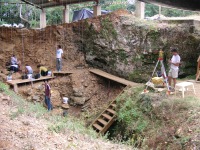Difference between revisions of "Excavation"
(Created page with 'File:lighterstill.jpgright|frame ==Origin== Latin ''excavatus'', past participle of ''excavare'', from ''ex''- + ''cavare'' to make hollow ...') |
m (Text replacement - "http://" to "https://") |
||
| Line 3: | Line 3: | ||
==Origin== | ==Origin== | ||
[[Latin]] ''excavatus'', past participle of ''excavare'', from ''ex''- + ''cavare'' to make [[hollow]] | [[Latin]] ''excavatus'', past participle of ''excavare'', from ''ex''- + ''cavare'' to make [[hollow]] | ||
| − | *[ | + | *[https://en.wikipedia.org/wiki/16th_century 1599] |
==Definitions== | ==Definitions== | ||
*1: to [[form]] a cavity or hole in | *1: to [[form]] a cavity or hole in | ||
| Line 14: | Line 14: | ||
Within the [[practice]] of ''excavation'', numerous specialized [[techniques]] are available for use, and each dig will have its particular features, which will determine the archaeologists' approach. [[Resources]] and other [[practical]] issues do not allow archaeologists to carry out excavations whenever and wherever they choose. These constraints mean many known sites have been deliberately left unexcavated. This is with the [[intention]] of preserving them for [[future]] generations as well as recognising the role they serve in the [[communities]] that live near them. In some cases it is also hoped that improvements in [[technology]] will enable them to be re-examined at a later date, with more fruitful results. Excavation involves the recovery of several types of [[data]] from a site, a place where there is [[evidence]] for [[past]] human activity. These data include [[artifacts]] (objects made or modified by humans), features (modifications to the site itself such as post molds, [[burials]], and [[hearth]]s), ecofacts (evidence for the local environment and resources being used such as snail shells, seeds, and butchered bones). and most importantly of all context (the [[relationships]] among the other types of data). Ideally, it should be possible from the excavation records to completely reconstruct the site in three-dimensional space. | Within the [[practice]] of ''excavation'', numerous specialized [[techniques]] are available for use, and each dig will have its particular features, which will determine the archaeologists' approach. [[Resources]] and other [[practical]] issues do not allow archaeologists to carry out excavations whenever and wherever they choose. These constraints mean many known sites have been deliberately left unexcavated. This is with the [[intention]] of preserving them for [[future]] generations as well as recognising the role they serve in the [[communities]] that live near them. In some cases it is also hoped that improvements in [[technology]] will enable them to be re-examined at a later date, with more fruitful results. Excavation involves the recovery of several types of [[data]] from a site, a place where there is [[evidence]] for [[past]] human activity. These data include [[artifacts]] (objects made or modified by humans), features (modifications to the site itself such as post molds, [[burials]], and [[hearth]]s), ecofacts (evidence for the local environment and resources being used such as snail shells, seeds, and butchered bones). and most importantly of all context (the [[relationships]] among the other types of data). Ideally, it should be possible from the excavation records to completely reconstruct the site in three-dimensional space. | ||
| − | The [[presence]] or [[absence]] of archaeological remains can often be suggested to a more or less high degree of [[probability]], by [ | + | The [[presence]] or [[absence]] of archaeological remains can often be suggested to a more or less high degree of [[probability]], by [https://en.wikipedia.org/wiki/Remote_sensing remote sensing], such as ground-penetrating [[radar]]. Indeed, grosser [[information]] about the development of the site may be drawn from this work but the [[understanding]] of finer features usually requires excavation though appropriate use of [https://en.wikipedia.org/wiki/Auger augering].[https://en.wikipedia.org/wiki/Excavation_%28archaeology%29] |
[[Category: Archaeology]] | [[Category: Archaeology]] | ||
Latest revision as of 23:56, 12 December 2020
Origin
Latin excavatus, past participle of excavare, from ex- + cavare to make hollow
Definitions
- 1: to form a cavity or hole in
- 2: to form by hollowing out
- 3: to dig out and remove
- 4: to expose to view by or as if by digging away a covering <excavate the remains of a temple>
Description
In archaeology, excavation is the exposure, processing and recording of archaeological remains. An excavation site or "dig" is a site being studied. Such a site excavation concerns itself with a specific archaeological site or a connected series of sites, and may be conducted over as little as several weeks to over a number of years.
Within the practice of excavation, numerous specialized techniques are available for use, and each dig will have its particular features, which will determine the archaeologists' approach. Resources and other practical issues do not allow archaeologists to carry out excavations whenever and wherever they choose. These constraints mean many known sites have been deliberately left unexcavated. This is with the intention of preserving them for future generations as well as recognising the role they serve in the communities that live near them. In some cases it is also hoped that improvements in technology will enable them to be re-examined at a later date, with more fruitful results. Excavation involves the recovery of several types of data from a site, a place where there is evidence for past human activity. These data include artifacts (objects made or modified by humans), features (modifications to the site itself such as post molds, burials, and hearths), ecofacts (evidence for the local environment and resources being used such as snail shells, seeds, and butchered bones). and most importantly of all context (the relationships among the other types of data). Ideally, it should be possible from the excavation records to completely reconstruct the site in three-dimensional space.
The presence or absence of archaeological remains can often be suggested to a more or less high degree of probability, by remote sensing, such as ground-penetrating radar. Indeed, grosser information about the development of the site may be drawn from this work but the understanding of finer features usually requires excavation though appropriate use of augering.[1]
